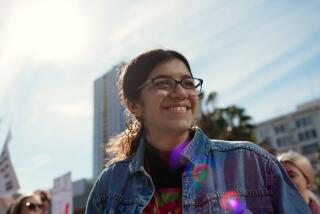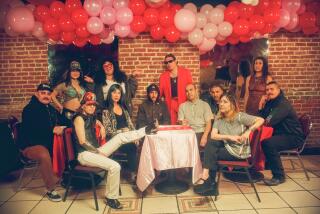Poets of Southern California Are Pulled Into View
On the broad lawn of Beyond Baroque, the venerable literary arts center in Venice, they fall together in semi-straight lines under a cloudy-bright sky: Part-time poets. Silenced poets. Mentor poets. Performance poets. Geographically challenged poets. Come-hell-or-high-water poets.
Among the assembled group of nearly 300, some wear thrift-store dashikis or rumpled top hats, fencing masks or Stetsons. Others carry portraits of absent or sick poet friends.
Dotting the perimeter are the hand-carried details that only poets could arrange precisely on the page of a day: Tarot cards, mud cloth sashes, nosegays of lavender, baskets of vivid strawberries, pass-around bottle of gin. Above it all, installed in a rented cherry picker on the Venice Boulevard sidewalk, photographer Mark Savage peers through the viewfinder of his Mamiya at an antsy assembly that answers his gaze with giggling and catcalls.
Savage calls the portrait he is about to make “The Big Picture,” and with it hopes to capture, and thus celebrate, a moment in the life of poets in Southern California, whose community is notoriously difficult to frame, and even more difficult to keep in focus. Echoes of photographer Art Kane’s “Jazz Portrait, in Harlem, 1958” (made more famous by a documentary “A Great Day in Harlem”), the indelible portrait of 57 jazz greats who collectively spanned the history of jazz, color the afternoon.
Often hidden behind the cliche that writer, here, means screenwriter, the region’s poets have more than made do with their stealth life, filling elite writing programs, winning prizes and organizing various kinetic literary centers and collectives.
But the low profile of the poetic personalities and styles hidden in L.A.’s sprawl has always been an issue. “It’s the problem about here ...,” says poet and anthologist Bill Mohr, negotiating hugs, shrieks and disposable-camera paparazzi as he crosses the lawn. “This is about making a group of writers visible. It will make people think, ‘How could we have missed so many poets?’ This is a thriving rambunctious community. This is awesome.”
“The Big Picture,” then, is an outing, in both senses of the word. It’s part reunion, part happening, part wake (for two who died on Easter weekend: Venice beat icon and poet John Thomas and Marta Mitrovich, a seminal figure in Orange County poetry). The event is the collective brainchild of Savage, Fred Dewey, the director of Beyond Baroque, and Amelie Frank, a member of the Valley Contemporary Poets. For five years, Savage has been compiling a visual catalog of L.A.’s poetry community with a series of stirring, intimate portraits. “I want the photographs to be as individual as they are,” he says. And “The Big Picture,” which will go on display at Beyond Baroque in several weeks, will draw these disparate spirits together.
The trio’s effort involves not just convening the poets, but looking more deeply into their work. “We’ve been trying to get more involved in documenting L.A. poetry history, high-caliber work across genres,” says Dewey. “I was looking for a way to preserve not just what is happening but the scope of what was happening, and start new dialogues. You can’t create new work if you don’t have a sense of your history.”
Just Who Is a
Poet, Anyway?
In style as in substance, the image of the Southern California poet is as elusive as a fresh simile. Everyone’s a poet: your next-door neighbor, the man who helps you select your weekend videos, the bookstore regular who once whiled away his lunch hour in belles-lettres --they’ve all made their way here today.
But for all the freedom that suggests, says Frank, it has often presented a quandary, both inside the community and out: Just who is a poet? And what is poetry?
Accordingly, says Dewey, as “Big Picture” planners tried to decide whom to include, “there was some dispute over the question of whether it should be major poets? Major published poets? Everyone who is actively involved in poetry?”
A steering committee of 15 plucked from various corners of L.A.’s literary community met in person and online to hash out particulars from the philosophical (“Who is a poet?”) to the practical (“Will we need Porta Pottis?”).
Ultimately, when it came to finalizing the guest list, says Frank, “the buck stopped at my desk. My criteria were: They have to be a poet. They have to be serious, they can’t be someone that goes to the mike to read from a journal. Publication is totally important, but it’s not the only requirement. There are fellowships, poetry hosts, teachers who have put their own work aside. There are spoken-word artists, academics who haven’t produced their own books. I’m not letting jokers and clowns in. I’m not letting in songwriters or stand-up comedians. And if you’ve been a jerk? This is not what it’s about.”
What it is about, says Dewey, is a concerted effort to document the extent of people’s writing. In many ways, “it’s as if the city is invisible to itself. It’s hubris to conceive of it as a singular base. Poets craft their language and present it to others. The challenge was to physically bring it all together,” says Dewey. “And of course all of it is a bit like herding cats,” he pauses, searching. “Or impalas....”
They Mingle, Try to
Forget Old Feuds
Pulled away from their long yellow pads, their dissertations or blue-book grading, the poets mingle, as Dewey and Frank had hoped. “There is a workshop I’m doing.” “I read that you’re living in San Diego now?” Some are aghast at friends’ gray hair. “My God!” shouts one man, peering up at an old friend. “You’re fat!”
Emotions are tuned high. “I had a lot of mixed thoughts about today,” says music writer and poet Lynne Bronstein, eyeing Savage up in his cherry picker moments before poet Larry Jaffe blasts his last call for people to find their places. “There are feuds. Old stuff. I figured, I’m trying to get into a positive mode. With John Thomas’ passing you realize how important it is to document. Only now do people realize how hard his life was, that he had so little money. He didn’t have the money to get his teeth fixed. Then you think about [the Oscars and] how much money these women pay to wear dresses for one evening....”
Terry Wolverton, a writer and former executive director of the L.A. Women’s Building, spends the afternoon retracing the steps of her many lives in L.A. “If you had done this, say, 20 years ago, it would have been a very different assembly,” she says. “Not because that there weren’t a variety of poets out there. It’s just that there was so much isolation.”
Pulling together today’s assemblage meant fliers, e-mail, telephone trees--and plain old word-of-mouth at readings or workshops.
And, of course, says Frank, with the invitation came the rules of the day: no alcohol (quickly broken). No dress code (easily followed). Bring a dish and copies of your work: broadsides, tapes, chapbooks, anthologies. Much of the work arrives in grocery bags, though some bring single 8-by-10 sheets sheathed in yellowing plastic.
April Declared Poetry
Month in California
Dewey rounds up the assembly. The governor’s office has come with a state proclamation declaring April California Poetry Month.
And finally, Savage calls the group to order. Their wavy lines get straighter. After a handful of tries, the group becomes quiet, and he begins. One frame. Then another and another. He stands, bends. The poets turn their faces upward, raise arms, wave. The sun peeks out, then disappears again. After that, it’s over.
“OK,” the photographer says as he stands, his pressed shirt now wrinkled, glasses slightly askew, “let’s party.”
“Look at this. All these poets coming together. I want to read what all these people are working on!” shouts Michael Datcher, poet and author of the memoir “Raising Fences.”
“I like this vibe,” says Peter Harris, poet and host of Inspiration House: VoiceMusic for Whole Living on KPFK-FM (90.7), bending into the rhythm of the moment, as if he’s bending into the music formed by so many voices, languages rising.
For all the differences, comparisons to Kane’s famous Harlem jazz portrait are immediate and unavoidable.
“There is something in [this photo] that is different from ‘A Great Day in Harlem,’” says Paul Vangelisti, poet and chair of the graduate writing program at Otis College of Art and Design. “If you looked at that photo then went to a record store ... it tells you exactly what was going on in jazz at that moment. Here, it is very odd.” He pauses, rolling the image over and over. “It documents L.A. rather than poetry.”
To Imani Toliver, who came out of Leimert Park’s World Stage, that isn’t necessarily a bad thing. For some, L.A. is neon and noir, but for others, like Toliver, it might be the very first Kwanzaa, the bales of hay at the first African Marketplace, or pet stores on Melrose, “things you don’t expect to come into the narrative. Another kind of L.A. icon.” The city, she explains, “inhabits your work in all kinds of way. I have this funny relationship with Los Angeles. There is this current that runs through it. Some are loud, like Angelyne, others are quiet, the whispers of the native.”
Poets move in and out of the crowd. Some convene in circles, eating muffins and tossing strawberries. Some read from their work. Promises are made and long silences broken.
Austin Straus turns to his wife, Wanda Coleman, and warns her that the line for food is wrapped around the corner. He urges her to hurry before it’s all gone. “I didn’t come to eat,” says Coleman, “This right here,” the poet says casting a glance, “is the real food.”
*
Mark Savage: “Souls and Passions: Portraits of Poets and Writers”: April 7 through May 30. Beyond Baroque Foundation and Literary Art Center, 681 Venice Boulevard, Venice, CA 90291
More to Read
Sign up for our Book Club newsletter
Get the latest news, events and more from the Los Angeles Times Book Club, and help us get L.A. reading and talking.
You may occasionally receive promotional content from the Los Angeles Times.






